The Whole Game in My Hand #12 - Part 1: Nintendo DS
Updates, New Features & Announcements
Games reviewed in this article:
- Monster Lab (DS) - action-RPG
- Spectrobes: Beyond the Portals (DS) - action-RPG
- Naruto: Path of Ninja 2 (DS) - action-RPG
- Away: Shuffle Dungeon (DS) - action-RPG
- Rune Factory 2: Fantasy Harvest Moon (DS) - simulation / RPG
- Pokemon Ranger: Shadows of Almia (DS) - action-RPG
- Chrono Trigger (DS) - jRPG
- Master of the Monster Lair (DS) - dungeon-builder RPG
- Luminous Arc 2 (DS) - strategy-RPG
- Age of Empires: Mythologies (DS) - turn-based strategy
- Tom Clancy's End War (DS) - turn-based strategy
- Populous DS (DS) - strategy
- Castlevania: Order of Ecclesia (DS) - action-platformer
Updates, New Features & Announcements
OK, straight off the bat a few new things - first off, I'm adding this new section to keep you informed of any updates. This time around the biggest change is that you will get two articles rather than one - the first will feature games for the Nintendo DS and the other will feature the Sony PSP and Apple iPhone. That is partly due to the fact that there are twenty-one games covered this quarter, and partly due to each individual review being longer. As GamerDad has stopped doing reviews, my tendency to do ~300 word snips has also faded ... meaning that you get ~800 or so word reviews per game. Another related change is that there is no 'Featured Review' this time. From now on, unless a game really screams out to be featured there will just be a set of standard reviews.
Also, I have been debating the future of this column with myself. This is for a few reasons: first and foremost, since I am doing fewer reviews in general, I find it harder to motivate myself to play games like Pokemon Ranger ... it isn't the writing of reviews so much as the playing of the games! Also, the time I take playing those games takes away from the time I can spend playing retro games on my netbook. So I have made a decision - I will continue playing as many games as I can, but will do 'synopsis' reviews presenting an aggregate opinion for games I don't want to play ... and keep those opinions short. Let me know what you think about the current state of the article and what you'd like to see in the future. And, if you feel strongly that I should dump the whole thing and focus on playing and writing about stuff like Hexplore and Stonekeep ... please let me know as I'm having some of those thoughts myself.
OK, back to games ... you know it must be the holiday rush of game releases when the PSP section has several games ... and some of them are even RPG's! Of course, the DS didn't let up the onslaught of games, and there were a load of good to excellent releases on the platform. The iPhone library continues to grow and deepen, to the point where I can't possibly keep up with all of the minor 'me too' releases and will therefore just select a few to highlight - for now sticking closest to those that appeal to my core cRPG love.
Nintendo DS – October / November / December Releases
Monster Lab (DS) (My Score 4/5, Rated E-10+)
While there are dozens of million-selling games for the Nintendo DS, few franchises on any platform have been part of over a decade of the constant popularity and high sales that has blessed Pokemon. Not surprisingly, there has been an endless stream of games that have sought to be 'the next Pokemon'. Some in concept only, others by adapting the 'gotta catch em all' mindset to a new concept. While Spectrobes has been the most visible of the recent entries into the 'Pokemon clone' field, you can now add Monster Lab.
Monster Lab is another example of 'truth in advertising' - you play as an apprentice mad scientist who is tasked to go around gathering parts to assemble new creatures. The setting is appropriate to the idea of assembling monsters - you are in Eerie, a supernatural world with an evil dictator named Baron Mharti. You are apprenticed to three different mad scientists, each of whom has a specialty: one specializes in Alchemy, another in Mechanical things, and the last in Biological studies. All three are aligned against the evil Baron, and so without further explanation ... so are you. And while that is a really cool premise to get you going with the game, it is also where the story pretty much begins and ends.
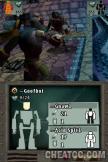
For the remainder of the story you take on quests that involve exploring the world gathering up parts to combine to create new monsters to use in battle. You can also gather 'parts' to upgrade existing monsters. While there are loads of side-quests and mini-games, they all center around a single thing: getting cooler and better monster parts to build bigger and more powerful monsters. This allows you to take on stronger enemies, thereby getting more cool monster parts, which allows you ... you get the picture.
But don't underestimate the content: you get to explore six different worlds as you take on quests, each with a variety of things to do. You also get to try out twenty-two different mini-games, and battle enemies ranging from trivial to nigh on impossible. You will need to pay attention as you develop your monster - things can get pretty rough at times.
The graphics are very well done - most of the time. The same is true for the sounds and music. Each has a very uneven quality - for example, the graphics of the environments you explore are highly detailed and colorful, whereas the battle graphics are dark and muddy and seem to lack detail compared to the rest of the game. There are cutscenes, but they lack a voice-over which seemed appropriate given the 'Professor Layton'-like style.
You can even take your monster into battle against friends wirelessly. This is a great concept that fits perfectly with the Pokemon style, allowing kids to find out how well they have done building monsters by pitting them against each other in battle. It adds even more to an already densely packed game.
So who is this game for? It is squarely aimed at boys around 10 or so. It has a bit of a freaky monster vibe, but isn't scary. I assumed that the 'mad scientist' thing would hook my older son, but it was my younger son - the former huge Scooby Doo fan - who was intrigued. The last couple of weeks have seen three games in heavy rotation in his DS - Spectrobes: Beyond the Portals, Korg DS-10 and this game. It is quite accurate to think of it as a sort of Frankenstein meets Scooby Doo meets Pokemon game.
With so much content and such an accurate targeting of their selected market, Eidos has a winner on their hands. It is not without some flaws - not the least of which is a lack of appeal to anyone outside of that target market. But for anyone attracted by the concept and the lineage of games that preceded this, it is an easy recommendation to go out and grab this cool little game.
Spectrobes: Beyond the Portals (DS) (My Score 3.5/5, Rated E-10+)
Spectrobes was a funny sort of game. When I initially played I predicted that the moment Pokemon Diamond and Pearl for the DS were released this game would become extinct. And to a large extent I was correct ... for a while. My younger son never really let it go - he found it charming and captivating and actually enjoyed it more than the Pokemon games. I found that there were quite a few kids who felt the same way. When I heard about the sequel, my assumption was that Disney was just trying to grab what they could before the franchise collapsed. And while I'm sure there is some of that going on, the amazing thing is that they managed to make this game better in every way than the original, to the point where I am wondering what they will do next with the franchise.
Spectrobes: Beyond the Portals picks up after the end of the original game, with the same characters featured in a much deeper and better written story. We're not talking epic here by any stretch, but the basic setup is more interesting than the original. Sadly, after getting you engaged based on some interesting kidnapping and subterfuge twists, the game settles into pretty much a 'find the next big boss and wipe them out'.
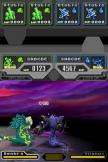
But Spectrobes fans are really not here for the story. They enjoyed the strategy involved in gathering up new Spectrobes using the mini-games to uncover them all. The mini-game can get tiresome after dozens and dozens of times, but this really isn't meant to be played in a long and sustained gameplay session. By playing a bit at a time, as most kids do, you lose the annoying grind feel and just get to enjoy evolving your Spectrobes. Again, this is a game that knows its' audience and has done a good job of catering the game to them.
Spectrobes enhances the 3D graphics from the original - and those were already pretty good. While not the best looking DS game, it is certainly not going to be mistaken for a GBA carry-over. The music tends to get annoying after a while of listening to the limited array of themes, but the rest of the sounds work well enough to remain unremarkable - and in a kid-oriented game that can be a good thing for the parents who have to listen to it incessantly!
The combat system is perhaps the biggest problem with the game, and mainly because of the annoying camera control. Since combat is real-time and requires you to lock on to enemies, the fact that the camera system makes it hard to engage anything not directly in front of you is really annoying. Fortunately they have simplified the combat system from the original which had you controlling both Spectrobes on the field; now you control one and the other does its' own thing, which is actually useful most of the time.;
Fortunately, as Obi-Wan said there are alternatives to fighting. You can excavate in order to advance the story and develop your Spectrobes, using the minerals you find as ways to gain power. Depending on how you manage the combat, this is a nice alternative - because the game is loaded with the need to grind levels, either to advance, or to out-stat your enemies so you can win battles in spite of the camera.
There are also some nice multiplayer features that allow you to interact with other players either online or locally. In a game that features so much collecting and developing, this is a definite 'must have' feature, but it is implemented in a robust way. ot only can you trade Spectrobes locally, you can 'sell' them online for points, use those points to but new items, upload your stats and find out how you rank against other players, and more.
Overall Spectrobes: Beyond the Portal is a solid second effort for the franchise, albeit one with some significant flaws. If this was a game marketed at a broader audience, I would advise you to 'Try It' before buying. But for the target market - elementary school kids and tweens - this is an easy 'Buy It' recomendation. Any doubts I had about this were dispelled last weekend. My kids were in a regional FiRST LEGO Robotics tournament, which involved ~6 hours of driving each way. I let them (and the other kid from the team we were driving) at the game, and they had a blast with it, taking turns with it in each of their DS systems. They weren't concerned about the camera or combat or the repetition - they were constantly comparing what they found as they explored. I still haven't pried it out of my younger son's DS case ... and probably never will.
Naruto: Path of Ninja 2 (DS) (My Score 3.5/5, Rated E-10+)
Back in The Whole Game in My Hand #8 I looked at Naruto: Path of Ninja (Believe it!), and commented that while pretty much everything about the game was mediocre, it oozed a certain charm that came from capturing the game world and characters with detail and respect. Fortunately not only does the sequel continue to exude that same charm, it has improved all of the core elements ... but unfortunately it still isn't a great game.
Two big fan complaints were that trying to capture 80 episodes of the show in the game caused the developers to barely sketch out the plot elements, and that very few of their favorite characters were playable. In Naruto: Path of Ninja 2 there are many more characters playable - in fact, over thirty characters and everyone my kids cared about was playable one way or another. Since that is something that is possible in pretty much every other Naruto game (of which there are many), it is nice that they added the characters.
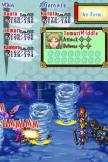
Naruto: Path of Ninja 2 features an original story that takes place somewhere after the original game - and after the other parts of the first anime series - and before the 'Shippuden' story begins. This means that Sasuke is not present in the story, but that doesn't diminish the story at all. There is still plenty of charm and character, as you really do continue to feel like you are playing through the anime, only this time it is through episodes you don't already know. The developers were able to make the story more dense as well, since they weren't stretching it so thin to fit into the game.
One thing I liked in the original game was the solid turn-based combat system. That isn't just retained - it is improved. You can change members of your party and also the leader, which changes the effects on your party. There are new Ninja Tags and other minor changes to the battle system - and it is also more challenging. This is good since the original game was so easy that it became boring at times, but another change removed the 'save anywhere' feature and replaced it with the typical console 'save point' system I loathe. This means making progress, dying, restoring to the last save point, and repeating that same segment until you finally make it through.
The story mode takes about a dozen hours to complete, but there is also a nice wireless multiplayer battle mode available. There is an online matchmaking mode where you take your party against other players online - but if you haven't spent time maximizing the skills of your characters you won't last long. This begins the cycle of advancing your characters in order to defeat other players so you can advance your characters ... and so on.
In general Naruto: Path of Ninja 2 is a solid game that is especially easy to recommend to fans of the anime series. Even the graphics look better! After losing my copy to my younger son, I ended up getting a second copy for the kids to be able to have wireless (but not quiet) Ninja battles! It is a rare example of a licensed game that is not only solidly done, but actually offers some depth of story and gameplay.
Away: Shuffle Dungeon (DS) (My Score 3/5, Rated E-10+)
When a game and a new developer are highly touted at their initial announcement, then fade into nowhere and then suddenly the game drops from nowhere ... it is seldom a good sign. AWAY: Shuffle Dungeon is the game and Mistwalker Studios is the developer. Known for the over-hyped and solid but under-delivering XBOX360 jRPG's Lost Odyssey and Blue Dragon, Mistwalker's announcement of a pair of DS games caused quite a stir, and while Blue Dragon Plus is still hotly anticipated, AWAY: Shuffle Dungeon seemed to have fallen off the map. There are several reasons why this happens, but only in the case of Wizardry 8 can I think of a case where the game wouldn't have been better off remaining lost. Sadly, AWAY: Shuffle Dungeon doesn't change that.
The premise of the game is that for a century the people of Webb village have been disappearing. You play as Sword, a young man who has come to town to settle down. However, noticing the plight of the people you look to take action. In terms of gameplay, AWAY: Shuffle Dungeon plays like the recent Zelda DS games in terms of being a touch-screen controlled top-down 2D action-centric game. Combat is in real time using a basic melee attack and a rather strange spell system. As you move through the dungeon you pick up colored orbs that represent spells. You can only cast the spell based on the orb adjacent to you, and you shift ball location using the L and R shoulder buttons.
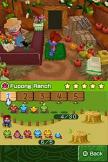
In contrast to games such as Zelda or dungeon crawlers like Izuna or Shiren the Wanderer, the entire current level of a dungeon is shown on the two screens - no need to scroll around to find the exit to the next level! Each dungeon is fairly small, containing just a few levels. Where things get interesting is when you try to get out of the level. When you first encounter a level, there appears to be no exit ... but just wait! One of the screens will have a countdown timer, and when that time expires, that screen is tossed away and replaced by a new level with a fresh set of enemies and loot. If Sword happens to be on that screen ... you will get tossed off as well and will lose health, all of your magic spell orbs, the person you have rescued, and have to restart that floor. Eventually one of the screens will 'shuffle' in a set of stairs to the next level of the dungeon.
The 'shuffle' mechanic is the only unique thing about the game, but unfortunately it isn't enough to sustain the game. The dungeon layouts are predefined and too few in number, meaning that things will start to look very familiar all too quickly. That is bad enough, but the game isn't great looking to start - it isn't ugly so much as bland and very average. The same is true of the music and sound effects, and the 'voice acting' reminds us why so many handheld games just use text. And so while it isn't a terrible game, AWAY: Shuffle Dungeon is inferior to many action games, inferior to many role-playing games, and inferior to many dungeon crawlers, leaving it no niche to claim as its' own. As such, I recommend that you just let it shuffle away ...
Rune Factory 2: Fantasy Harvest Moon (DS) (My Score 4/5, Rated E)
It is amazing to think that at one time I actually had more PSP than DS reviewsin one of these articles - that was over a year ago in #7, and just happened to include my review of Rune Factory: A Fantasy Harvest Moon, which I gave a rating of 4/5. I remarked that it started woefully with cliche after cliche ... yet managed to emerge as a really solid game. Based on that I had mixed feelings for this one - on the one hand I was concerned that the cliches would overwhelm the quality, but on the other I hoped that they would take everything good and fix the shortcomings and make a truly great game. Neither happened, though, and we are left with a solid sequel with pretty much the same balance of good and bad features.
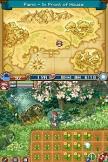
Once again you start the game as an amnesiac wandering into town, thus time meeting a nice girl whose father just happens to have a small farm to lend you to get on your feet and develop. You progress much as you did in the original - working the land, taming monsters, meeting neighbors, and so on. However, from the beginning it is clear that large chunks of the game are off-limits at this point. This compels you to get married and procreate as quickly as possible in order to open up the rest of the content, pretty much destroying any impact of the whole parent-child aspect of the game.
Rune Factory 2: Fantasy Harvest Moon is a very good game but a lost opportunity in the end - it has improved many of the issues the original had with interface and presentation, adding a nice twist in the multi-generational aspect, but added too many limitations getting it all to work. It is still a very nice marriage (pun intended!) of traditional Harvest Moon farming simulation and action-RPG, and has loads of gameplay. It just leaves you feeling that once again the game failed to achieve the potential it showed throughout.
Pokemon Ranger: Shadows of Almia (DS) (My Score 2.5/5, Rated E)
Back in 2006 we were introduced to a new type of Pokemon game - one where the goal wasn't to catch and train, but to befriend Pokemon and team up with them to defeat evil defilers of nature. The game was pretty light fare, accepted as an interim measure while waiting for the 'real' Pokemon games - Diamond & Pearl. Those arrived, continuing the trend of being very kid-friendly, some of the best licensed games ever made, and having a very deep turn-based combat system. In contrast, Pokemon Ranger felt much like melting a huge bag of cotton candy and realizing that it is really just a quarter cup of sugar at its' core.
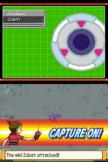
Two years later, we have another Pokemon Ranger game. And here is my basic thought: 'where's the beef'? Two years after the first game, a year and a half after the release of the 'real' Pokemon games, less than six months before the release of another 'real' Pokemon game, and THIS is all they can manage? A change of setting and a couple of tweaks?
As with the original game, you befriend Pokemon by drawing a circle with the stylus. In the original, if the Pokemon touched the circle before you finished you'd have to start again. Now it gradually fades so you can keep going rather than starting over completely. This makes it easier, but also takes away some of the unnecessary annoyance. Once you have befriended a Pokemon they stay with you until you need to use them to accomplish a task. The only exception is your 'partner' Pokemon, who is with you from start to finish unless you swap him out for another. In Pokemon Ranger: Shadows of Almia you can choose from 17 different partners, which is much better than the two you could select from in the original.
The problem is that there is not much story to motivate you, no attachment to the Pokemon to keep you going, and basically very little depth that will make you want to keep playing. Since you lose any Pokemon you use, you will soon find yourself backtracking to re-catch the same Pokemon again when you encounter something that requires that particular skill again. There are some other minor tweaks to the interface and graphics, but nothing remarkable ... this is a completely forgettable game that is a reminder that while there are many good Pokemon games, no franchise is immune to the curse of shovelware.
Chrono Trigger (DS) (My Score 4.5, Rated E-10+)
Porting a classic game is always a tricky proposal. When you produce multiple ports of the same game for just about every system ever released, you risk ending up looking like you are just trying to repeatedly bilk your fans out of cash (I'm thinking specifically of Square Enix and Final Fantasy I & II here). On the other hand, by leaving a cult classic sitting for too long, you run the risk of the port feeling outdated and getting lousy reviews based on that, or of tweaking the game to modernize it and getting trashed by fans for messing with something that wasn't broken. Chrono Trigger, originally released in 1995 for the SNES, is widely regarded as one of the greatest jRPG's ever released and therefore has been wildly anticipated since announced. For the DS release, very little was changed in the game - there is some added content but mostly it is a faithful reproduction of the original. And it works beautifully.
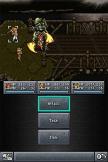
You play as Chrono as the story begins in 1000AD. It is an 'alternate history' game where you travel through history from the dawn of civilization to a post-apocalyptic future recruiting allies in order to save the world from destruction. Actually, it doesn't start in such a grand fashion - a time portal is accidentially opened at a demonstration of a teleportation device, which leads to a time displacement dilemma that has to be solved in the past, but which also causes problems back in the present, which ends up with the heroes escaping to the future! It is a complex and interesting story full of well developed characters that will keep you playing until the very end. Speaking of which, the DS version adds an alternate ending you can access once you complete the standard ending. The DS version also features the updated graphics and cutscenes produced for the PSOne port as well as a cleaned up translation.
The combat system is turn-based, but uses the active-time battle system that was introduced in Final Fantasy IV and had become popular at the time. It is still turn-based, but turns proceed based on the Speed attribute of each character, as well as how quickly the player can enter commands. The DS version allows you to run the game in turn-based mode, so that at the start of each round the game is paused to allow input of commands. Either way it is an engaging and nicely done combat system that remains exciting and challenging.
There were many things about Chrono Trigger that were new in 1995 that have since been done again and again. Yet the game remains fresh and the quality shines through. This is a testament to the quality of the production and the story. Each era the player can access is interesting and has plenty of characters and quests and lore to keep things interesting, and the variety of skills and combat will keep you focused on tactics throughout the long and twisting story. It was a great game in 1995, and it remains a great game in 2008 - easily one of the best RPG's of the year and a must-have for anyone with a Nintendo DS.
Master of the Monster Lair (DS) (My Score 2.5/5, Rated E-10+)
Way back in The Whole Game in My Hand #6 I looked at the original Dungeon Maker for the PSP, noting it " is a good and solid effort, but not a great one. Perhaps if they decide to make another game in the series they can focus on the combat - now THAT would make for an incredibly addictive experience! Until then, Dungeon Maker: Hunting Ground is a solid game with a number of innovative features that is fresh and fun, even if it ultimately falls a bit short of the mark."
So why do I mention this? Because Master of the Monster Lair essentially IS Dungeon Maker, but with a somewhat modified setup to hook in a younger audience. To quickly summarize what that means: it is a good concept with some interesting design and gameplay mechanics that ultimately falls short of its' goal. Oh, and to anyone who touched the original game - including my kids - this blatant attempt to rope in a younger crowd by re-casting itself in the guise of the latest anime / manga / whatever thing just really doesn't work.
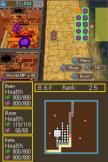
The game isn't terrible, just terribly average: you happen to find a magical talking shovel and are tasked to build a dungeon for the dual purpose of spreading peace and promoting tourism. Really - I can't make this stuff up. But while it isn't presented in a way that takes itself seriously, neither is it done lightly enough to work as parody: instead it is just silly.
Every flaw of Dungeon Maker is repeated here: gameplay is repetitive more than fun, advancing is slow and not very rewarding, and everything that happens is bland and predictable. One of the strangest things is the level-up system: rather than gaining experience based on the monsters you draw into your lair and destroy, you are rewarded based on the food you create after leaving the dungeon ... yes, this game could have been called 'Cooking Dungeon'! It would have been nice as a way to augment your character development, but as the only method for advancement you are destined to a life of mindless 'recipe grinding'. But wait - isn't that how things work in Dungeon Maker I & II? Yes - but in those games (particularly the new one) it is more like a crafting or alchemy system, whereas here it is over-simplified to the point of removing not just the challenge but also the fun.
One good aspect of Dungeon Maker is also present here: the better your dungeon design the better the class of monsters you'll attract and therefore the higher quality drops you'll get. But that is once again mired down in simplistic and lackluster action-based combat that gets bland and repetitive before you finish your second level. Also bland and repetitive are the graphics, which look even worse compared to some of the other games mentioned in this review. There is just no reason to get this game ... none.
Luminous Arc 2 (DS) (My Score 4/5, Rated T)
Another sequel to a game reviewed in The Whole Game in My Hand #7, Luminous Arc 2 takes place four centuries after the original game, as an era of peace has ended in Carnava. The original Luminous Arc had the misfortune to release just as the string of excellent PSP strategy-RPG's were landing (Jeanne D'Arc followed by Final Fantasy Tactics and Disgaea), but was also hampered by a lackluster story and presentation. And while Luminous Arc 2 was released just as excitement was starting to build for the upcoming Fire Emblem DS, it has improved enough to stand on its' own as the best strategy-RPG of the fall release season.
Differentiating a fantasy-based strategy-RPG is not easy: they all offer mission based gameplay interspersed with cutscenes and minor story elements and dialogue. Yet it is in the subtleties of those elements that games succeed or fail: are the characters memorable, is the story so bad you notice it, did the developers manage to keep the combat interesting and provide for strategic depth? The good news is that on all these counts the game succeeds. The premise is basic - you play as Roland, a knight's apprentice who accidentally has a Runic Engine fuse onto his hand and is sent out to work with the 'good' witches in the hopes of getting them to work with the knights against the bad witches and evil demons. The Runic Engine allows Roland to learn magic spells, as the good witches show him how to become a Runic Knight. There is plenty of humor and pathos and serious moments where you realize that you have come to actually care about the plight of these characters.
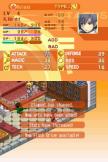
Strategy-RPG combat can often be impersonal - but not here. Everything centers on Roland, who can learn skills and spells from nearby witches through a process called 'engagement' (not with ring on bended knee, but there is an image of a witch in a nice white dress!). Combat offers loads of strategy and variety and is generally excellent. One problem is that while I applaud the increased difficulty in terms of strategy, there are too many times when difficulty is raised by just tossing more enemies at you during a battle or reinforcements at the end of battle or chaining multiple battles together without the ability to save or resupply. It is a cheap tactic that is more frustrating than fun. Also in this category is the uneven distribution of experience based solely on who places the killing blow on an enemy, as this ends up with an unbalanced squad.
While the graphics of the original were bland, the music was very good - and here it is even better. Atlus recognized this by offerring a soundtrack CD with pre-orders of the game, and certainly the fine music enhances the experience - which is no small feat in a 40+ hour game! There is also the ability to take on other players via wireless battles, but that is a minor feature and one that it seems few gamers are using. That is not a major issue, as there is so much game here that you won't find the experience wanting. The game didn't gain much attention during the holiday rush, which is unfortunate, but now is a great time to grab this fine game and get to battling!
Age of Empires: Mythologies (DS) (My Score 4/5, Rated E-10+)
One of the first classic PC game franchises brought to the DS in 2006, Age of Empires: Age of Kings took a chance by changing the gameplay mechanic from real-time to turn-based - and it was a chance that paid off nicely. It allowed them to focus on a series of story-arcs that provided increasing challenges as you progress and resulted in a very satisfying experience, and what remains one of my favorite DS games nearly three years after release.
Age of Empires: Mythologies starts with the solid foundation of the Age of Kings engine and turn-based combat system, but provides an entirely new set of campaigns in new settings and with so many new ways of doing things that it hardly feels like the same game except for one thing: it is excellent. There are three civilizations you get to experience: the Egyptians are your starting point, providing tutorial levels as well as a great set of challenges. From there you play as the Greeks and the Norse. As history has taught, these civilizations have each taken very different approaches to how they handled war and peace and advancing their culture and technology. These differences translate nicely into unique gameplay challenges - do not underestimate the difficulty of accomplishing this task at a time where it feels like every new strategy game promises different playable factions but delivers little more than similar gameplay with different colored shirts.
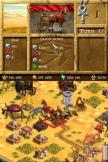
In terms of presentation, Age of Empires: Mythologies is gorgeous: the 2D graphics of the maps look wonderful and are highly varied within a campaign and from setting to setting. The characters are nicely detailed and the massive mythological creatures maintain an awesome presence suitable to their historical description. The music and sound effects are also very well done, and there is plenty of voice acting to further pull you into the story. Each setting has a different musical theme, and this is not just another set of drab background tracks but an original and memorable effort.
If I had to pick out a single criticism, it would be the fact that the game is nearly impossible to control solely with the stylus or the face buttons. This means that you will typically be using some combination of controls while also holding the DS - and if that sounds cumbersome that is because it is cumbersome. Another minor criticism is that unlike other strategy games with varied objectives, every mission in Age of Empires: Mythologies requires you to destroy all enemy troops and constructs to succeed. While generally not a major issue, sometimes it would be nice to have some alternate success criteria to allow you to use more varied tactics.
One disappointment with Age of Empires: Age of Kings was the limited multiplayer. This is another area where Age of Empires: Mythologies is a glowing success. You can test your skill against friends either online or locally, using multi-card or single-card play. Unlike single player mode, in multiplayer you have various objectives other than just destroying everything, giving you and your friends plenty of options for victory and more incentive to keep playing.
It is generally the case in PC strategy games that the single player gets you involved and the multiplayer keeps you playing for a while. That is rarely true for handheld games, but Age of Empires: Mythologies might just change things! With a strong set of stories, solid multidimensional rock-paper-scissors system for combat, and a nicely implemented multiplayer system, this is a game that strategy fans shouldn't miss.
Tom Clancy's End War (DS) (My Score 3.5/5, Rated T)
Tom Clancy's End War for the DS and PSP paint a bleak World War III scenario in which the EU has fully merged into a single nation, and the Russian and American forces are thrown into a global conflict that is playing out on the European continent. It is a great premise for a solid strategy game that offers hours of challenging tactical play.
The tutorial is detailed and does a great job at unfolding the strategic engine underpinning the game and helping you plan your campaigns for success. Once you complete the tutorial missions it is time to pick sides - Europeans, Americans or Russians. Immediately you see the opportunity for replayability, which is delivered in the form of each faction having strengths and weaknesses.
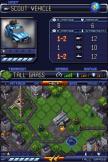
Tactics play a huge role in determining success or failure: you cannot simply hope to 'run & gun' your way through these missions without dying repeatedly. The game plays out on a hex grid, with all of the standard features of a turn-based strategy game we have learned through years of Advance Wars games. One nice feature is that all actions are queued until you choose to end the turn - so you can completely undo everything you've set up if you suddenly change your mind, which is a great option. There are a couple of tactical additions - jamming and blocking. Blocking does what it sounds like - it gets in the way of your enemies so they cannot move. Jamming surrounds them with two or more of your units, meaning that not only is their movement restricted but you get significant bonuses to attack and defense above the standard 'rock paper scissors' rules.
Technically the game is also quite solid, but unremarkable. The graphics are nicely detailed but not spectacular - over the course of the game things start to look the same in the various battle screens. That really isn't surprising given the size and scope of the game, I just wanted to note that the graphics are not a major reason to grab this game. Neither is the minimalist approach to sound, which mainly consists of battle and vehicle sounds with a fairly standard soundtrack and occasional generic voice bits.
Probably the one missing technical element is the microphone - given that 'voice command' was such a highly touted feature of the console versions of the game it seems a shame that there wasn't *any* use of it in the DS game. Of course, since the DS version is the best of any of the releases, that is easily forgiven.
Multiplayer includes several ways of battle a friend - hot-seat, local wireless, and WiFi. All work very well and are an addicting way to spend an afternoon when the weather is lousy. But the coolest feature is that you can create maps and share them with friends wirelessly in battle. The map editor allows you to store up to 32 maps, and you can test them out in the 'quick action Battle Mode before taking them online against friends.
When I first heard that the End War games for the DS & PSP were going to be turn-based strategy games, I was excited for the possibilities, but also concerned that since the focus was on the console versions that the handhelds would get generic 'shovelware' Advance Wars clones. Fortunately that isn't the case. While the DS version is the better choice, the PSP is also a great value - there are nearly 100 missions in the single player campaign with plenty of primary and secondary objectives to keep you very busy, and the multiplayer is addictive as you work on both your strategy and your mission-building skills. A great choice for any strategy gaming fan on either handheld.
Populous DS (DS) (My Score 3/5, Rated E-10+)
It is now twenty years since the original 'god game' was released. While perhaps not the first of its' kind, Populous was the seminal incarnation of the genre on the PC platform and has defined it ever since. The lineage includes games such as Sim Earth, Black & White, The Sims and Spore. Now the classic returns in a faithful reproduction of the original for the Nintendo DS. Is the glory maintained? Read on and find out!
The DS has become the home for many classic PC games, but the quality has varied widely, from lousy games such as The Settlers, to average games such as Sim City and Zoo Tycoon, to solid games such as 1701A.D. and Age of Empires. However, the best of those games were the ones that were updated or reimagined in some way. Since Populous is pretty much a straight port of the original, my expectations were fairly low in terms of evaluating this as a 'new release', but my hopes were still high that this would peg my 'nostalgia meter' in a way that the awful 'The Settlers' failed to do last year.
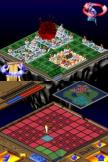
The concept of Populous is simple: you are one of five deities who needs to build up your land and your followers while a rival demon is simultaneously building up his forces. This all leads to an epic final battle that is decided by who prepared and nutured and exploited their worshippers best. In many ways this sounds like a classic RTS formula, but the difference is that rather than directly manipulating situations, you are using your divine influence to enable your followers to complete tasks for you. So instead of building houses, you shape the land to be favorable for worshippers to build houses, and so on.
Controls are handled entirely through the sylus, and it is an excellent system - once you get used to it. The bottom screen is where you work all of your divine magic, with the results shown on the top screen. So to alter the terrain you simply drag the wireframe up or down on the bottom screen and watch the actual terrain change on the top screen. You also use the bottom screen to manipulate your divine powers and move your relics around to attract followers.
The graphics are sharp and crisp but retain a very retro feel - which works very much in the favor of the game. Populous looks and sounds like an old classic, with nice variety in the different areas and a very limited soundtrack that you will happily just turn down after a while. I was amazed that The Settlers suffered from poor framerates and load-times, so I was thrilled that Populous looks great with very short loads and no signs of slowdowns at any time. There is nothing that gets in the way of enjoying the game.
There is a load of content here, but also a minor complaint: in the twenty years since the original was released, the concept and mechanics have been used and reused and expanded upon greatly, to the point that Populous DS often feels like doing the same few simple tasks over and over again. It is fun and will keep you busy for hours on end, especially if you grab some friends and engage in wireless multiplayer battles.
But the question comes down to the initial attraction - if this is a game you have played before but haven't touched since Sinead O'Connor was comparing things to the letter 'U' (or whatever that song was about), then it is a fairly easy 'Buy'. I know I have greatly enjoyed it, but as I always do in cases like this ... I gave the game to my kids to play around with on a outlet shipping trip with an old friend. They enjoyed it initially, and between thr two of them it consumed the entire hour or so we were driving. But for the ride home they had no interest - nor have they desired to touch it again since. It was a novelty with little to hook them for longer than a few minutes, which is how I think it will feel to many gamers ... so I advice trying the game before buying if that is possible.
Castlevania: Order of Ecclesia (DS) (My Score 4.5/5, Rated T)
There are a few common themes in the handheld Castlevania games I've been playing since getting the original GameBoy back in 1989: side-scrolling, jumping, cool music, and that I constantly struggle. Oh, and the games have been almost universally excellent. Castlevania: Order of Ecclesia is the seventh Castlevania handheld game I've bought (1 GameBoy, 3 GBA, 1 PSP UMD, 1 PSP download PSOne game, and now 3 DS games) and while it might not be the best of the series, it is an excellent game that hasn't strayed far from my DS since I got the game.
One reason it isn't ever far from my DS is because it is one of the harder games I own. While I know I'm not good at Castlevania games in general, this is even a hard game for my older son, who does much better with these than I do (yes, it has already hit THAT point!). While there are some significant amounts of 'die & retry', especially with bosses, in general the game is just difficult. Rather than typical weapons, you absorb glyphs that power your magic-based weapon attacks. You collect hearts as you progress, which can be used to power-up special attacks. Boss battles will typically require several attempts to learn the proper method and finally succeed. Fortunately the save rooms are not too far apart and therefore there is a minimum of backtracking throughout the game.
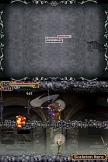
Castlevania: Order of Ecclesia is unlike other entries in the series in that there is a central outdoor town with loads of missions and characters and a real central feel to it that will serve as a motivation through much of the game. Sadly many of the characters in the town lack any dimension until later in the game. Perhaps my biggest complaint with the game is that the story feels lackluster and packed with amnesiac cliches. Also, while I am glad that there are multiple endings, it isn't made particularly clear how to get the 'good' ending early on, meaning you will be doing loads of hunting around and frustrating backtracking.
Aside from these issues, Castlevania: Order of Ecclesia is amazing - the soundtrack is superb, graphics are some of the best I've seen in the series, areas are varied and there is finally solid use of outdoor spaces as well as dungeons, and more. It is technically the best of the DS series, and one that any fan of the series should try - just be warned that it is frustratingly difficult at times.
Nintendo DS – The RPG Outlook for the Next Quarter
Good thing that the first quarter is the 'dead zone' so we can get some relief from the unrelenting DS RPG release schedule, right? Right?!?! Oh, I guess not ... just take a look:
- My World, My Way
- Legend of Ys: Books I & II
- Fire Emblem: Shadow Dragon
- Dragon Quest V: Hand of the Heavenly Bride
- Blue Dragon Plus
- Avalon Code
- Puzzle Quest: Galactrix
- Suikoden Tierkreis
- Valkyrie Profile: Covenant of the Plume
- Pokemon Platinum Version
- Final Fantasy Crystal Chronicles: Echoes of Time
- Infinite Space
- Gauntlet - delayed from June ... August ... and September. Now supposedly April '09
- A Witches' Tale - possibly now delayed until Q2 '09?
Well, that is it for the DS part of the reviews ... see you soon for the PSP and iPhone review! Until then, happy gaming!

Information about
#Handheld RPGDeveloper: Unknown
SP/MP: Unknown
Setting: Unknown
Genre: RPG
Combat: Unknown
Play-time: Unknown
Voice-acting: Unknown
Regions & platforms
Unknown
· Platform: Unknown
· To be announced
· Publisher: Unknown
More information
Other articles
- The Whole Game in My Hand #12 - Part 2: Sony PSP / Apple iPhone
- The Whole Game in My Hand #11
- The Whole Game in My Hand #10
- The Whole Game in My Hand #9
- The Whole Game in My Hand #8
- The Whole Game in My Hand #7
- The Whole Game in My Hand #6
- The Whole Game in My Hand #5
- The Whole Game in My Hand #4 - March/ April '07
- The Whole Game in My Hand #3 - Feb. '07
- The Whole Game in My Hand #2 - Dec. '06 / Jan. '07
- The Whole Game in My Hand #1 - November 2006

